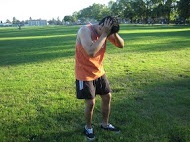A typical vision condition that causes blurred vision is called astigmatism. It occur when the cornea is irregularly shaped or sometimes, the curvature of the lens on the eye. It can lead to discomfort of the eyes or headaches.
Some may have degree of astigmatism. Slight astigmatism normally does not affect vision nor needs treatment.
The specific cause of astigmatism is unknown. It can be hereditary and commonly present from birth. It can decrease or increase any time.
Tests that can be done for astigmatism will include comprehensive optometric examination. It is necessary for the optometrist to recommend eyeglasses or contact lenses that correct by altering the way light go into the eyes.
Types of Astigmatism
There are three main types of astigmatism:
- Myopic astigmatism. One or both primary meridians of the eye are near sighted.
- Hyperopic astigmatism. One or both principal meridians are far sighted.
- Mixed astigmatism. One primary meridian is near sighted and the other is farsighted.

What causes it?
The curvature of the cornea and lens bends the light toward the eye in order to focus it accurately on the retina at the back of the eye. The surface of the cornea or lens has a different curvature.
Change normally occurs in adulthood and can lead the development of naturally arising cataracts. Sometimes, astigmatism is caused by the lens shape of the eye
Symptoms of Astigmatism
The indications of astigmatism may vary in each person. Some don’t have any symptoms at all. The indications of astigmatism include:
- Blurry, fuzzy, distorted vision at all distances
- eyestrain
- difficulty seeing at night
- squinting
- eye irritation
- headaches
What symptom can be associated to Astigmatism?
Lazy Eye or amblyopia occurs when astigmatism in one eye isn’t corrected.
Treatment for Astigmatism
Minor cases of astigmatism may not involve treatment. The doctor may treat astigmatism that origins vision problems by using one of the following methods.
Corrective Lenses
Corrective eyeglasses and contact lenses recommended by a doctor are the most usual and minimum invasive handlings for astigmatism.
Orthokeratology (Ortho-K)
Orthokeratology (Ortho-K) is a treatment that uses definite contact lenses to momentarily correct the irregular curvature of your cornea. The benefits of Ortho-K are only current when using it. Your vision will return to its former state after stopping Ortho-K.
Surgery
The doctor may prescribe refractive surgery in severe case. This kind of surgery includes by means of lasers or small knives to reform your cornea. This will enduringly alter your astigmatism. Talk to the doctor about the risks and benefits before getting surgery for astigmatism.
Laser Surgery
Laser surgery can also cure some types of astigmatism. The laser adjusts the shape of the cornea by eliminating a little amount of eye tissue.
